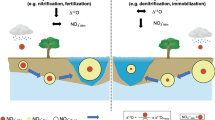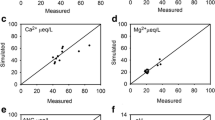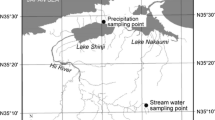Abstract
We investigated the atmospheric concentrations and deposition fluxes of major ions to the Turkey Lakes Watershed (TLW) between 1980 and 1996. During that time, daily SO4 2− concentrations in precipitation decreased markedly, while NO3 −, NH4 +, and H+ concentrations remained roughly constant. It appears that precipitation acidity did not decrease in spite of declining SO4 2− concentrations due to a concurrent and counterbalancing decrease in the concentrations of Ca2+, Mg2+, and K+ in precipitation. The reasons for the decline in base cations are unknown, but this decline is probably related to decreasing emissions of soil-derived particles from agricultural, industrial, and road sources. A similar situation was seen during the same period in other parts of Canada, the eastern United States, and Europe. Wet, dry, and total (wet + dry) deposition fluxes of sulphur (S) and nitrogen (N) were estimated annually for the years 1980–96. The 17-year mean annual total (wet + dry) deposition of S to the watershed was estimated at 38.5 mmol m−2 y−1 (range 24.3–50.3). Total S deposition decreased by 35% from the early 1980s (1982–84) to the mid-1990s (1994–96), a decline consistent with the 23% decline in annual SO2 emissions in eastern North America during the same period. In contrast, the annual total (wet + dry) deposition of oxidized N ranged from 39.8 to 60.4 mmol m−2 y−1, with a 15-year mean of 50.1 mmol m−2 y−1 and a net increase of 10% between the early 1980s (1983–85) and the mid-1990s (1994–96). This is in keeping with a 10% increase in NOx emissions in eastern North America during the same period. For both S and N (oxidized), wet deposition dominated over dry deposition as the major mechanism for atmospheric input to the watershed. Annually, wet deposition accounted for approximately two-thirds of the total atmospheric deposition of both S and N. Dry S deposition was due more to gaseous SO2 deposition (two-thirds of dry S deposition) than to particulate SO4 2− deposition (one-third of dry S deposition). Dry deposition of oxidized N, however, was dominated (95%) by gaseous HNO3 deposition, with minimal input from particulate NO3 − deposition. Compared to several selected watershed/forest sites in Canada, the United States, and Europe, the estimated total deposition of S and N at the TLW was relatively high during the measurement period.
Similar content being viewed by others
Author information
Authors and Affiliations
Additional information
Received 5 October 1999; accepted 1 March 2001.
Rights and permissions
About this article
Cite this article
Sirois, A., Vet, R. & MacTavish, D. Atmospheric Deposition to the Turkey Lakes Watershed: Temporal Variations and Characteristics. Ecosystems 4, 503–513 (2001). https://doi.org/10.1007/s10021-001-0024-1
Issue Date:
DOI: https://doi.org/10.1007/s10021-001-0024-1




